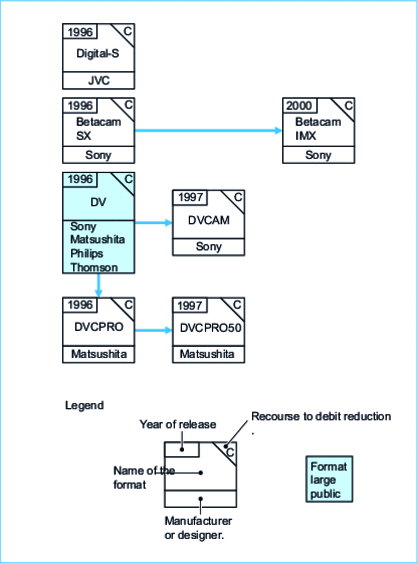Overview
Read this article from a comprehensive knowledge base, updated and supplemented with articles reviewed by scientific committees.
Read the articleAUTHOR
-
Alain DELHAISE: Engineer from the École nationale supérieure des télécommunications - Consulting engineer - Professor of video technology at the École nationale supérieure Louis-Lumière
INTRODUCTION
In the "Magnetic recording of images" article , the reader will find all the theoretical aspects and the succession of the main analog VTR formats, followed by what we call the first generation of digital VTRs.
The purpose of this article is to present the professional formats launched by the industry since 1993, which are widely used by production and post-production companies on the one hand, and broadcasters on the other. We will add a few new technologies applied in these devices, insofar as they provide interesting functionalities for the operator.
These recent formats (figure 1 ) are characterized by the recording of component signals and by the systematic use of digital bit-rate reduction, also known as compression, applied in different ways depending on the format.
In 2003, it's safe to say that the formats recently released in standard definition (525 or 625 lines) probably represent the last formats ever produced, since the VCR is gradually giving way in television equipment to video servers, whose introduction in the mid-1990s marked an important stage in the evolution of hardware and operating methods. The main criticism levelled at VTRs concerns the linear access imposed on every sequence on the tape, which can lead to a waiting time of around three minutes when rewinding the tape in its entirety. In post-production and broadcasting, the changeover has already taken place to a large extent; only production is holding out, until a common standard for recording on rewritable discs from the DVD

will see the light of day. Of course, this doesn't mean the end of VCR use, because on the one hand, the hundreds of millions of recorded cassettes constitute a heritage that must and will have to be accessed, and on the other hand, certain digital formats are being reborn...
Exclusive to subscribers. 97% yet to be discovered!
You do not have access to this resource.
Click here to request your free trial access!
Already subscribed? Log in!

The Ultimate Scientific and Technical Reference
This article is included in
Signal processing and its applications
This offer includes:
Knowledge Base
Updated and enriched with articles validated by our scientific committees
Services
A set of exclusive tools to complement the resources
Practical Path
Operational and didactic, to guarantee the acquisition of transversal skills
Doc & Quiz
Interactive articles with quizzes, for constructive reading
Magnetic recording of images: digital formats
Bibliography
In Engineering Techniques
Standards
- Information Technology – Digital compression and coding of photographic still images: JPEG profile registration, SPIFF profiles, SPIFF tags, SPIFF color spaces, APPn tags, SPIFF compression types and registration authorities (REGAUT) - ISO/CEI 10918-4 - 08-99
- Information Technology – Coding of moving images and associated sound for digital storage media up to approx. 1.5 Mbit/s - ISO/CEI 11172 - 1993
- Information...
Organizations
Joint Photographic Experts Group (JPEG) http://www.jpeg.org
Moving Picture Experts Group (MPEG) http://www.chiariglione.org/mpeg
Manufacturers
(non-exhaustive list)
Panasonic http://www.panasonic-broadcast.com
Sony http://www.sony.net
Exclusive to subscribers. 97% yet to be discovered!
You do not have access to this resource.
Click here to request your free trial access!
Already subscribed? Log in!

The Ultimate Scientific and Technical Reference